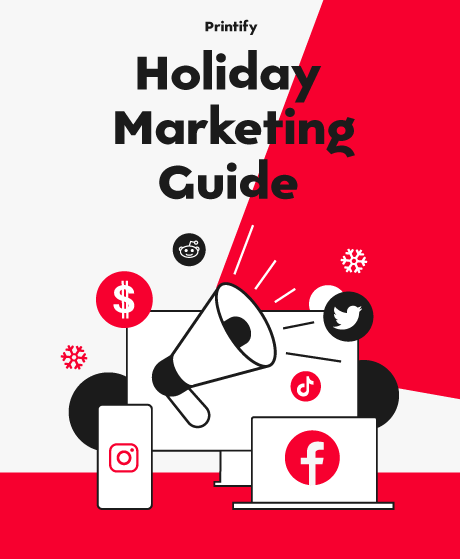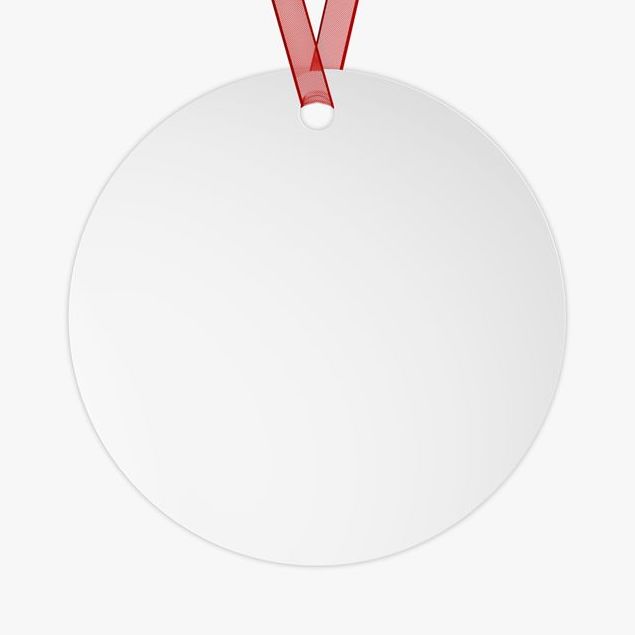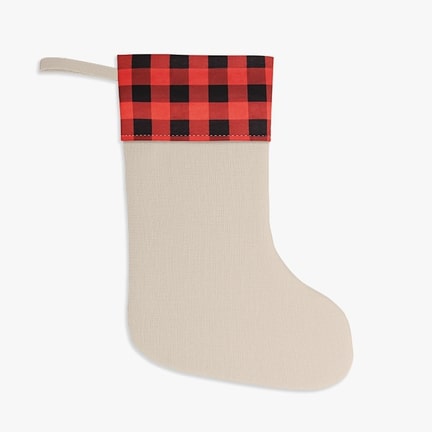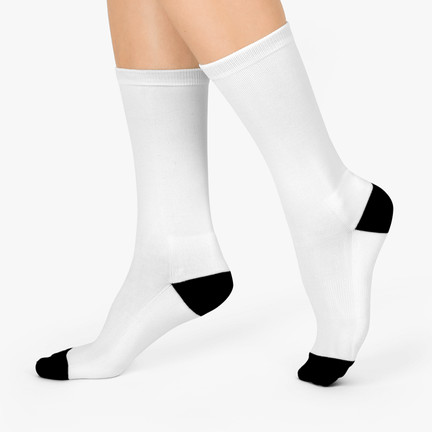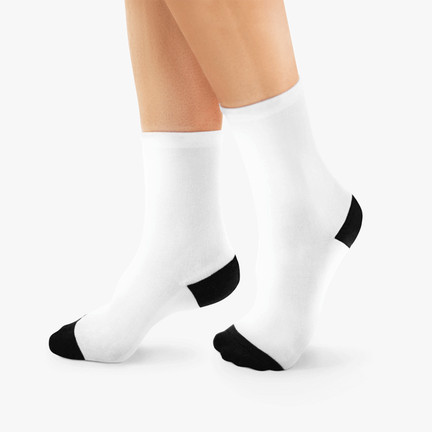The Ultimate Holiday Marketing Guide
More customers and bigger sales – the holiday season is marked by millions of eCommerce shoppers ready to spend on gifts and winter goods. ‘Tis the season to triple your profits by planning and executing holiday marketing campaigns well in advance.
This comprehensive holiday marketing guide will give you all the tools and information you need to come up with successful holiday marketing ideas and capitalize on the financial tsunami that will sweep through online retail. Let’s get started.
Chapter 1
Why and When to Prepare for the Holiday Season
The weeks leading up to Christmas are the most important time for eCommerce. Large distributors and niche stores alike participate in holiday-themed promotions and campaign events, drastically increasing traffic and potential revenue.
In fact, the fourth sales quarter, which includes Thanksgiving, Hanukkah, Kwanzaa, and Christmas – has brought in more online shoppers than ever. eCommerce sales doubled in 2021 and accounted for 14.7% of total holiday retail sales in 2022.
When Does the Holiday Season Start?
The winter holiday season begins right around the start of Thanksgiving weekend. It continues until the end of the New Year and ends well into January. eCommerce stores launch their marketing strategy and holiday sales promotions as early as October.
It’s wise to start holiday marketing efforts weeks in advance to entice holiday shoppers with timely marketing messages. Consider planning holiday marketing campaigns from the start of fall to November to build traffic from the Black Friday sales momentum.
Plan Ahead With These Financial Points
In 2022, 56% of shoppers in the United States planned to complete a part of their yearly holiday shopping from online retailers. The gap between global eCommerce sales growth and traditional retail sales has shrunk, increasing the profitability of online stores.
These are the key financial takeaways you should consider before planning and launching a successful holiday marketing campaign.
- $211b in holiday sales revenue was generated in the US for 2022.
- 11.9% expected increase in the total revenue for eCommerce sales in 2023.
- $754 on average is spent on holiday gifts and goods by consumers.
- 21% in average product discount rates during November and December.
- 47.7% of online sales are made through a smartphone, 52.3% on desktop.
Plan Ahead With These Consumer Trends
Use holiday trends to find insights into consumer preferences, shopping behaviors, and seasonal expectations. Customer trends help marketers develop relevant and timely content, align their messaging, and provide search-friendly holiday advertising.
These key behavioral takeaways help develop an idea of internet usage trends and the need to prioritize search engine optimization (SEO) as a tool for bringing in online traffic.
- 75% of online users change their purchase decisions from Google search results.
- 1.3 times yearly increase in searches for where to buy/find/get on Google.
- Millennials spend the most on holiday shopping, followed by Gen X customers.
- 65% of customers state that holiday pricing is their primary purchasing influence.
- 70% of consumers wait for holiday sales discounts before they start buying.
- 50% of shoppers buy clothing and accessories as their top purchase category.
Chapter 2
Holiday Marketing on eCommerce Platforms vs Marketplaces
Where are you selling? Define a sales channel to help determine your overall eCommerce strategy and holiday marketing tactics. You can either sell and advertise from your own store page or promote product listings on a marketplace website.
The difference between platform and marketplace models involves customization, costs, traffic, and time management. While you may already have a preference, it’s important to note the strengths and weaknesses of each approach.

The platform approach.
Create an online store hosted by an eCommerce platform and website builder. Examples of hosting platforms include Shopify and WooCommerce.
Pros:
- The ability to design your own storefront, which is ideal for branding.
- Platforms help generate customized websites that track store analytics and customer data.
- This approach offers more control over distributing content, promotions, and branded holiday messaging.
Cons:
- Platforms take more time to create and customize and require some experience in web design.
- Managing a web domain will incur higher costs for marketing and driving user traffic.
- To attract consistent buyers, the store must maintain long-term marketing efforts.
Holiday marketing on an eCommerce platform.
eCommerce platforms rely more on producing and distributing content to reach specific audiences. Use platform tools to publish SEO-friendly holiday content, automate email marketing, implement Google Ads campaigns, and showcase customer reviews.
Make sure your website provides a great experience by keeping loyal customers up to date. For example, optimize a Shopify marketing strategy by creating an email subscription for campaign newsletters and publishing holiday blogs and landing pages.

The marketplace approach.
Pros:
- The main appeal of selling on marketplaces is being able to rely on built-in search algorithms and integrated payment systems.
- Creating and managing a store is beginner-friendly and less expensive.
- Marketplaces have their own existing user base.
Cons:
- Marketplaces are harder to customize and have less reliable means of tracking user data.
- These platforms come with strict policy rules and processing fees that can limit your holiday promotions.
- Strong competitor base of merchants who share the same goals.
Holiday marketing on an eCommerce marketplace.
Festive season marketing is highly competitive. Optimize marketplace listings to generate more visibility and traffic by adding holiday keywords throughout your content, updating tags and descriptions, and offering seasonal discounts.
Use integrated ad programs to advertise your holiday products within the marketplace and on social media. For example, use the Etsy Ads program to create website promotions and connect your social channels to share product highlights.
Chapter 3
Products to Sell During the Holiday Season
What are you selling? Boost online sales by centering your marketing strategy on products with the highest holiday purchases, pre-holiday sales increases, and flexible discount rates. See what product categories are popular, profitable, and promotional.
- The most popular online product categories during the 2022 holiday season were toys, electronics, apparel items, and gift cards.
- The product categories with the highest growth over the pre-holiday season were toys, jewelry, gift cards, sporting goods, books, and office supplies.
- The categories with the highest holiday sales discounts were toys, electronics, and apparel items, ranging from 19%-34% off.
Let’s look at our top ten bestselling products for the busy holiday season with high turnover rates and flexible profit margins.
1. Premium Hoodies and T-Shirts
With year-round demand and versatility for any customer demographic, hoodies, and custom t-shirts are a winter holiday favorite. Offer seasonal apparel designs to highlight your holiday marketing strategies, from ugly Christmas sweaters to branded merchandise with custom prints and embroidery.
2. Greeting Cards
Holiday greeting cards are a staple for traditional sales, an easy and inexpensive item to create and deliver. Use greeting cards as a quick accessory to enhance your holiday marketing campaigns with seasonal visuals, and add them as bundle deals together with other products.
3. Christmas Accessories
Consider all types of Christmas accessories to supplement your holiday marketing ideas, from stockings and gift-wrapping paper to Christmas tree ornaments and postcards. Take advantage of that extra holiday spirit and steer your customers towards that unique and perfect gift.
4. Winter Pajamas
The morning of Christmas Day comes with the honorable tradition of sinking into fresh new pajamas, sitting by the fire, and getting lost in the rush of treats and presents. Custom holiday pajamas are a great product to sell online if you cater to families or have a holiday niche.
5. Fleece Blankets
Blankets are a great holiday offer for a home goods collection and a perfect gift for any potential customer demographic. Fleece and other soft-material blankets are an exceptional favorite during the colder months and have a large surface for holiday branding.
6. Sublimation Socks
Socks have an unfairly bad reputation as a gift idea. Still, many people find the simple joys of holiday socks as a gesture of sincerity and humble expectations. Sublimation socks have seen a lot of popularity due to their all-over-print aesthetic and colorful design features.
7. Holiday Mugs
These perfect warm drink companions add an extra highlight for Christmas marketing ideas, especially when combined with personalized seasonal designs. Delight shoppers with holiday mugs to invoke the heartwarming spirit of staying cozy at home as the days grow short.
8. Canvas Art
Premium art is a solid gift idea, whether it’s canvas photography of cherished holiday moments or a stunning creative piece. Canvas and graphic art posters are great for both holiday-themed designs and when catering to a specific online niche that celebrates your work.
9. Scented Candles
For more holiday ambiance, try adding decorative candles to your online store. Infuse homes with the holiday spirit, illuminate festivities, and add a scent of seasonal fragrances perfect for gifting and enhancing cozy gatherings.
10. Phone Cases
Smartphones are responsible for many online sales, so why not include these protective cases in your online store? Well-designed phone cases make for great holiday accessories and can act as a canvas for branded visuals, logos, and holiday slogans.
Find these and more products to sell during the holiday season in our Printify Catalog.
Chapter 4
Holiday Email Marketing Tips and Tricks
Businesses have adapted to multiple marketing channels to increase holiday sales, but email has remained the best way to connect and promote to customers directly.
Email marketing is essential for purchasing and shipping information, introducing policy updates, sharing holiday promotions, and marketing campaign newsletters.
Follow our holiday marketing tips to plan your strategy, create engaging content, and increase revenue with a timely and themed email marketing campaign.
Plan Different Email Types
It’s not enough to create a promotional newsletter with a link to holiday deals and discounts. Sending out different types of holiday emails will diversify your content with frequent seasonal messaging and entice shoppers to participate in sales events.
Set up an email subscription page to sign up new customers and consider incorporating some of these potential email types as part of your holiday marketing campaign:
- Welcoming message.
Make sure your new and existing customers feel appreciated. Give them a warm welcome and offer a sneak peek at the upcoming promotions. - Exclusive offers.
Advertise holiday discounts and offer coupons to loyal customers. - Product highlights.
Feature a list of store recommendations and gift ideas. - Countdown timers.
Set up a timer for the launch of holiday sales discounts. - Post-purchase messages.
Add a personalized thank you email after every purchase. - Abandoned cart recovery.
Entice customers to return and finish their purchase after leaving.
Offer Deals and Discounts
Email marketing drives direct engagement. Customers are more likely to return to your store if you offer them personalized value – timely holiday deals and discounts. Make sure to leverage holiday shopper enthusiasm by promoting coupons and big savings.
Not only will discounts boost conversion rates with higher traffic and demand, but these offers will also make holiday shopping more rewarding. Create a sense of urgency and increase customer satisfaction and brand loyalty.

Structure Your Emails Effectively
Start by deciding what kind of language fits your style and makes your brand stand out. When writing, focus on timely information, personalize where possible, add visuals and structure with consistent formatting:
Subject Line
Make the subject short and to the point, focusing mainly on attention-grabbing phrases and holiday keywords.
Preheader Text
The preheader is the extension of the subject line – a quick email preview. Include the main points of the email.
Email Body
Write the most important information first. Introduce the campaign and give concise offers, deals, and resources that directly benefit the customer.
Call to Action
Let customers know what to do after opening the email. For example, browse gift ideas, read articles, buy products, or claim discounts.
Click-through Links
Offer customers direct links to easily click through your catalog and content, and add a button for users to follow up on call-to-action statements.
Images and Visuals
Decorate your email with striking holiday-themed images, making sure the dimensions work for both desktop and mobile users.
Use Email Marketing Tools
There are a variety of email marketing tools that can make holiday campaigns a lot easier. Take advantage of automated responses and custom templates to free up more time and resources for planning a successful holiday marketing strategy.
Use automated templates where possible, including for welcoming emails, transaction notifications, order receipts, and abandoned cart reminders. Consider signing up for third-party services such as Sendinblue, Omnisend, and Bloomreach for emailing software.

Personalize Customer Emails
Use your customer contact information to create personalized emails. Categorize contacts based on certain criteria and send each target audience information most relevant to them.
For example, offer sales coupons for regular customers and advertise special offers for seasonal shoppers. Make sure each buyer receives content based on their shopping behavior and interests. This will help improve your customer experience and create a memorable relationship with the brand.
Define Clear Deadlines
Make customers feel at ease when making a stressful order before the holidays by setting clear expectations and deadlines for your holiday marketing campaign.
Provide as much transparency as possible, including discount days, estimated production times, expected delivery dates, and everything else the customer should know before receiving your product.

Produce Engaging Content
Email marketing is an excellent tool to share other content pieces and resources for further advertising. Learn about successful holiday content marketing in chapter five.
Build your brand by publishing engaging content that provides value for your customers and sharing it via your email campaign. Create holiday gift guides, seasonal blog posts, and holiday challenges.
Check our article on holiday email marketing for further information.
Chapter 5
How to Create a Successful Holiday Content Strategy
Anticipate trends, interact with your audience, and produce engaging and relevant content. Planning out a content strategy can make or break your holiday marketing campaign. Know these content marketing tips to help you win over the holiday season.
Market Research and Trends
Market research can help you identify what type of content is popular and how to promote it. We’ve already analyzed past holiday sales data, but don’t stop your research there. Create relevant content by following trends, analyzing other campaigns, and using eCommerce tools.
- Research competitors.
Find inspiration by studying holiday marketing campaigns from other businesses. Explore their marketing channels and identify popular holiday content ideas. - Follow social media.
Social media channels can help you monitor emerging holiday trends. Adapt your strategy by familiarizing yourself with existing social media content and customer preferences. - Use keyword research tools.
Platforms like Google Trends, Ahrefs, and Semrush can help you find high-ranking holiday keywords. Add relevant ones to your content to increase potential holiday traffic.
Know Your Audience
Even if you’ve found useful data to support your holiday marketing strategy, you should always remember to check back and ask your customers for their input.
Use surveys, comments, testimonials, and direct messages to learn customer preferences and tailor promotions to their needs. Creating more personalized content will enhance engagement, build brand loyalty, and increase the chance of conversions during the holiday season.
Create a Content Calendar
Add more structure and organization to your content strategy by preparing a schedule well in advance. Planning with a marketing calendar helps maintain a consistent and cohesive message throughout the season without having to publish in a last-minute rush.
Quick Tip
Don’t oversaturate your holiday schedule. Try to prioritize one marketing tactic for each holiday event to better track your efforts and maximize your content’s impact.
Audit Your Existing Content
Don’t forget to update your previous content, especially if your business has published holiday-related marketing before. This will help you find outdated but high-performing content that can be repurposed and leveraged for the new holiday season.
Small business owners might be unable to afford the marketing resources to produce content throughout the holidays. Auditing existing content ensures the business doesn’t lose out on previous marketing work, maintains brand consistency, and stays current with trends.
Analyze the Results
Make the most of your holiday marketing by monitoring your progress and adjusting when needed. Tweaks may be required to optimize your content, fix technical issues, and answer reader inquiries.
Going viral will undoubtedly take a lot of time and effort, so you’ll have to find new ways to boost visibility and increase engagement. Once your marketing is successful, make sure you can handle the new influx of traffic and orders.
Chapter 6
Creating a Proper Holiday Social Media Campaign
This is essential for holiday marketing strategies, as social media is the leading marketing channel worldwide.
Digital advertising platforms like Facebook, TikTok, Instagram, YouTube, and X (formally known as Twitter) are excellent for generating exposure, making them essential tools.
Distribute effective social media marketing content to reach the highest volume of potential customers. These holiday marketing tips will help you create a successful social media marketing campaign.
Set Clear Objectives
Decide what goals your social media marketing efforts will aim to achieve. You could plan to increase website traffic and boost sales with good deals or enhance brand awareness and customer loyalty with viral content. Ensure your effort aligns with desired outcomes, so you know what to track and measure.
Setting a unified objective will also help align your social media posts in a focused direction, ensuring consistency across all channels and throughout the holiday season.
Collaborate With Influencers
eCommerce retailers agree that the authentic and personal touch of influencer marketing brings in the highest return on investment from all marketing channels. However, finding a reliable influencer willing to promote your holiday marketing isn’t easy.
Research using hashtags related to your business, identifying potential influencers based on content and engagement rates, and crafting a personalized pitch to collaborate. Define clear payment terms and guidelines and track their performance.
Alternatively, connect with a social media service or agency specializing in influencer marketing to find potential collaborators and set up a campaign contract.
Get Among the Holiday Festivities
Make sure your business knows how to bring holiday cheer and celebrate with authenticity. Like influencer marketing, customers respond to sincere holiday engagement, even if it’s a simple Christmas greeting.
Try celebrating with active holiday events, encouraging customers to engage in the holiday spirit. This could include supporting charitable causes or participating in seasonal giveaways.
Provide Value
Add more value through your holiday marketing campaign with different social media posts that respond to the needs and desires of your target audience. Use multiple forms of content to reach a broader audience and cultivate more brand recognition with:
Helpful Content
Create educational or charitable content, including useful guides and practical tips for holiday shoppers.
Exclusive Offers
Create educational or charitable content, including useful guides and practical tips for holiday shoppers.
Entertainment
Delight your audience with holiday-themed videos, quizzes, or interactive polls.
Personalization
Tailor your content for specific audiences, respond to their interests, and encourage collaboration.
Responsive Engagement
Respond to comments, messages, and interactions to let customers know you value their engagement.
Use Multiple Channels
Don’t limit yourself to a single social media platform. Implement multichannel marketing by sharing promotional content across different platforms to maximize your reach. Broader brand awareness should encourage more engagement and conversions.
Quick Tip
Create your social media business accounts in advance to align all marketing channels under one username. This will maintain brand consistency and help limit customer confusion.
Analyze Your Engagement
Keep track of your social media analytics to see if anything needs to be changed, assessed, or fixed while implementing your holiday marketing strategy.
If a post doesn’t receive as much attention as you hoped, it might not be what customers are looking for. Or it isn’t optimized for their content feed with the right hashtags, topics, and subject matter.
Engagement metrics such as likes, follows, comments, and impressions are great tools for setting up measurable campaign objectives and tracking performance over long periods of time.
Use Paid Social Media Ads
Use social media programs like TikTok Ads, Facebook Meta Ads, and Instagram Ads to create promoted posts and banners that appear in organic social media feeds.
Social media ad programs will set a fixed price for every 1,000 impressions, and you can usually set up a daily budget to finance a specific campaign timeline. Pay ads are a large investment, so they might not be the best choice for small businesses and self-employed entrepreneurs.
Chapter 7
Don’t Forget About Holiday SEO
We’ve learned that user search behavior is a defining metric when it comes to website visibility and purchase decisions. Use these SEO marketing tips to rank your store higher in user search results and increase potential holiday traffic.
Keyword Optimization
Seasonal keywords are holiday-related phrases and search queries that customers often use to make informed buying decisions.
Use Google Analytics and other research tools to find relevant holiday-themed keywords. Add them to your content, titles, product descriptions, and headings to match user intent. This will increase the likelihood that customers will find your store or content organically.
Create Holiday Content
Content is not just the king of customer engagement. It’s also crucial for optimizing your search engine rankings and overall traffic performance.
By creating holiday content, your business provides additional value for seasonal customers and carries more potential search keywords. The added value and visibility attract backlinks from other businesses, increasing website credibility and offering a competitive edge.
Optimize for Mobile Devices
Smartphones make up a great share of online traffic and holiday purchases, but they’re also crucial for improving SEO.
Google prioritizes mobile-first indexing for many new sites and continues to increase the relevance of smartphone browsing each year. Optimizing for mobile devices ensures a seamless online shopping experience and lower rates of losing sales from poor site performance.
Enhance Images and Videos
Websites that load in one second have a 2.5 times higher eCommerce conversion rate than websites that load in five seconds.
Capture the customer’s attention quickly – ensure faster load speeds by optimizing your images and videos. Resize image dimensions if necessary, compress media files to reduce their size without losing quality, and add alternative text with relevant keywords to improve search engine indexing and user accessibility.
Analyze User Experience
Everything you produce and publish for customers should be simple to understand and easily accessible.
Create a mock customer journey to analyze how long it takes to reach the checkout after seeing your marketing content. Optimize with clear navigation where possible, add plenty of click-through links, and consider creating more personalized product recommendations to keep customers engaged.
Chapter 8
Avoid These Holiday Marketing Mistakes
It’s very rare to see your holiday eCommerce strategy succeed without any issues along the way, but you can take steps to prevent the most common mistakes. Check these ten marketing mistakes to avoid when preparing for the holiday shopping season.
1. Neglecting Planning
Start planning your holiday marketing strategy early. Last-minute marketing efforts will end up looking disorganized and inconsistent. Without a detailed strategy, you’re more likely to miss out on marketing opportunities and forget important eCommerce holiday dates.
2. Overlooking Customers
Understand your audience’s preferences and analyze their behavior across multiple marketing channels. By overlooking customers, your holiday marketing ideas will lead to irrelevant content and produce less engagement.
3. Ignoring Competition
Remember to analyze past competitor strategies and keep up-to-date with other holiday marketing campaigns. Failing to track and learn from competitors will decrease your chance to stand out, explore new trends, and find relevant holiday marketing ideas.
4. Excessive Promotion
Publish content consistently, but don’t overpromote your products and push excessive updates. Constantly reminding your audience about the holiday campaign without adding any value in return will send customers away and negatively impact your brand.
5. Overcomplicating Your Content
Be catchy, memorable, and quick to the point. Complicated and lengthy content will fail to catch the audience’s interest. If you don’t capture users’ attention in the first few seconds, they’re unlikely to follow through.
6. Not Checking Analytics
Always keep track of your marketing channel analytics. These tools are designed to help you optimize content and track campaign performance. Not monitoring campaign metrics will prevent you from making adjustments and improving your content.
7. Not Optimizing for Mobile
Make sure your content is well-optimized for smartphone users, including both holiday marketing and your payment checkout. Neglecting mobile-friendly formatting will alienate many holiday shoppers and decrease your potential revenue.
8. Lacking a Multichannel Strategy
Multichannel strategies help businesses reach different demographics or the same audience across a range of marketing platforms. If your holiday marketing plan relies solely on one platform, it will limit your reach and potential audience volume.
9. Misaligning Your Messaging
Plan your marketing messaging with a consistent and coherent style – define a shared goal across all platforms and marketing content. Inconsistent messages can confuse customers and make your campaign less trustworthy.
10. Forgetting Post-holiday Engagement
Keep contact with your audience and share marketing messaging even after the holiday season ends. Many marketers neglect customer engagement and fail to cultivate further leads and insights for future campaigns.
Holiday Marketing Campaign Checklist
Develop amazing holiday campaign ideas to boost sales and increase your chance of making the last quarter of the year the most profitable. Focus on early planning and execution. Implement various strategies and marketing channels, including SEO, social media platforms, email marketing, and content creation.
Start Early
Holiday planning matters. Define a campaign theme and launch fall marketing content well in advance.
Research Trends
Analyze market trends and competitors to align your content with consumer preferences.
Find Holiday Bestsellers
Promote and sell products that perform the best during the winter season.
Use Email Marketing
Use personalized emails to connect with customers directly, offer transparent campaign messages, and promote amazing deals.
Produce Quality Content
Create a diverse content calendar, including exclusive offers, product highlights, and holiday guides.
Leverage Social Media
Use both free and paid social media advertising strategies to increase customer engagement.
Provide Value
Make sure your content is relevant to the user. Offer helpful insights or provide customer entertainment.
Use Multichannel Marketing
Combine multiple marketing platforms to reach a broader audience and increase your brand visibility.
Optimize SEO
Add relevant keywords, create holiday-themed content, optimize your website, and ensure a mobile-friendly experience.
Stay Responsive
Engage with customers, respond to feedback, and check comments and interactions to build a strong customer-brand relationship.
Analyze and Adjust
Regularly monitor your campaign metrics to make data-driven changes and apply better marketing strategies
Make It Happen Today!
- Table of Contents
- Why and When to Prepare for the Holiday Season
- Holiday Marketing on eCommerce Platforms vs Marketplaces
- Products to Sell During the Holiday Season
- Holiday Email Marketing Tips and Tricks
- How to Create a Successful Holiday Content Strategy
- Creating a Proper Holiday Social Media Campaign
- Don’t Forget About Holiday SEO
- Avoid These Holiday Marketing Mistakes
- Holiday Marketing Campaign Checklist

